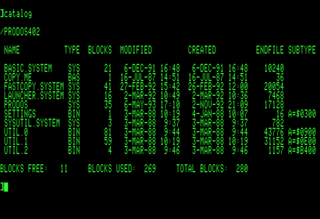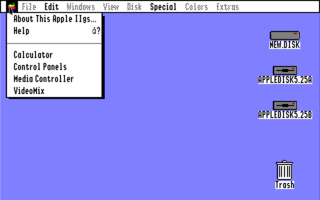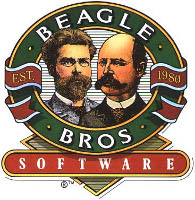
The Apple IIGS, the fifth and most powerful of the Apple II family, is a 16-bit personal computer produced by Apple Computer. While featuring the Macintosh look and feel, and resolution and color similar to the Amiga and Atari ST, it remains compatible with earlier Apple II models. The "GS" in the name stands for "Graphics and Sound", referring to its enhanced multimedia hardware, especially its state-of-the-art audio.

ProDOS is the name of two similar operating systems for the Apple II series of personal computers. The original ProDOS, renamed ProDOS 8 in version 1.2, is the last official operating system usable by all 8-bit Apple II series computers, and was distributed from 1983 to 1993. The other, ProDOS 16, was a stop-gap solution for the 16-bit Apple IIGS that was replaced by GS/OS within two years.

GS/OS is an operating system developed by Apple Computer for its Apple IIGS personal computer. It provides facilities for accessing the file system, controlling input/output devices, loading and running program files, and a system allowing programs to handle interrupts and signals. It uses ProDOS as its primary filing system. GS/OS is a component of Apple IIGS System Software versions 4.0 through 6.0.1, and was the first true 16-bit operating system for the IIGS.

AppleWorks was an integrated office suite containing a word processor, database, and spreadsheet. It was developed by Rupert Lissner for Apple Computer, originally for the Apple II platform and launched in 1984. Many enhancements for AppleWorks were created, the most popular being the TimeOut series from Beagle Bros which extended the life of the Apple II version of AppleWorks. Appleworks was later reworked for the Macintosh platform.

The Oberon System is a modular, single-user, single-process, multitasking operating system written in the programming language Oberon. It was originally developed in the late 1980s at ETH Zurich. The Oberon System has an unconventional visual text user interface (TUI) instead of a conventional command-line interface (CLI) or graphical user interface (GUI). This TUI was very innovative in its time and influenced the design of the Acme text editor for the Plan 9 from Bell Labs operating system.

Diskworld was a disk magazine for the Apple Macintosh computer system, published by Softdisk beginning in 1988. It was a sister publication of Softdisk for the Apple II, Loadstar for the Commodore 64, and Big Blue Disk for the IBM PC. Diskworld ceased publication in 1998.
Dangerous Dave is a 1988 computer game by John Romero. It was developed for the Apple II and DOS as an example game to accompany his article about his GraBASIC, an Applesoft BASIC add-on, for the UpTime disk magazine.
The Print Shop is a basic desktop publishing software package originally published in 1984 by Broderbund. It was unique in that it provided libraries of clip art and templates through a simple interface to build signs, posters and banners with household dot-matrix printers. Over the years, the software has been updated to accommodate changing file formats and printer technologies.

Beagle Bros was an American software company that specialized in creating personal computing products. Their primary focus was on the Apple II family of computers. Although they ceased business in 1991, owner Mark Simonsen permitted the Beagle Bros name and logo to be included on the 30th anniversary reboot of I. O. Silver, released on December 12, 2014 by former Beagle programmer Randy Brandt.

A disk magazine, colloquially known as a diskmag or diskzine, is a magazine that is distributed in electronic form to be read using computers. These had some popularity in the 1980s and 1990s as periodicals distributed on floppy disk, hence their name. The rise of the Internet in the late 1990s caused them to be superseded almost entirely by online publications, which are sometimes still called "diskmags" despite the lack of physical disks.

Loadstar was a disk magazine for the Commodore 64 computer, published starting in 1984 and ceasing publication in 2007 with its unreleased 250th issue. It derived its name from the command commonly used to execute commercial software from a Commodore 1541 disk: LOAD "*",8,1, with inspiration from the word "lodestar".

Softalk was an American magazine of the early 1980s that focused on the Apple II computer. Published from September 1980 through August 1984, it featured articles about hardware and software associated with the Apple II platform and the people and companies who made them. The name was originally used on a newsletter of Apple Software pioneer company, Softape, who in 1980 changed its name to Artsci Inc.

Softdisk, originally Softdisk Magazette, was a disk magazine for the Apple II computer line, published from 1981 through 1995. It was the first publication of the company that was also known as Softdisk, which would go on to publish disk magazines for other systems, other software, and later be involved in Internet access, hosting, and development.
Resource Central was an Apple II publishing house in Overland Park, Kansas. It was founded by former Softalk columnist and Beagle Bros software author Tom Weishaar. Resource Central was responsible for many Apple II publications, including:
The Apple Pugetsound Program Library Exchange (A.P.P.L.E.) is a users' group established in 1978 by Val Golding.
The Byte Works, founded and run by Mike Westerfield, was a key player in the history of developer tools for Apple II computers. Its first product, the ORCA/M assembler, developed jointly by Westerfield and Phil Montoya, was a powerful assembly language development environment, complete with a Unix-style shell, which ran on 8-bit Apple II computers.

Juiced.GS is a print magazine/newsletter for Apple II computer users. Although the name implies a focus on the Apple IIGS, its coverage encompasses all Apple II systems. It is the longest-running Apple II publication and, since 1999, the only Apple II publication still in print as of 2018.
KansasFest is an annual event for Apple II computer enthusiasts. Held every July at Rockhurst University in Kansas City, Missouri, KansasFest typically lasts five days and features presentations from Apple II experts and pioneers, as well as games, fun events, after-hours hallway chatter, late-night runs out to movies or restaurants, and more. A number of important new products have been released at KansasFest or developed through collaborations between individuals who likely would not have gotten together. Some of the most notable have been the introduction of the LANceGS Ethernet Card, and the Marinetti TCP/IP stack for the Apple IIGS.

Computist was a magazine devoted to the Apple II personal computer that was published by Charles R. Haight under the SoftKey Publishing name, between 1981 and 1993, for a total of 89 issues. The magazine was based in Tacoma, Washington. Originally launched as Hardcore Computing, the 'hardcore' part was formally dropped from the title with the 27th issue.

Where in Europe Is Carmen Sandiego? is a 1988 European geography-based educational computer game in the Carmen Sandiego detective mystery franchise. It was originally published by Broderbund in 1988 for Apple II, Commodore 64, and DOS, and ported to the Amiga and Macintosh in 1989. It is the third Carmen Sandiego title, after Where in the World Is Carmen Sandiego? (1985) and Where in the USA Is Carmen Sandiego? (1986). Under the guidance of The Acme Agency's chief, the player completes cases to catch Carmen's henchmen; they accomplish this by traveling to European cities to find clues relating to the crook's last known whereabouts, and by gaining enough character data to issue a warrant of arrest. Once the player has captured all 15 thieves, they can pursue Carmen herself.













